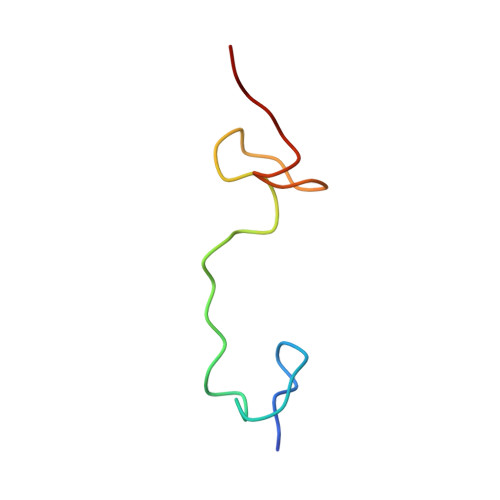Target specificity of human immunodeficiency virus type 1 NCp7 requires an intact conformation of its CCHC N-terminal zinc finger.
Ramboarina, S., Druillennec, S., Morellet, N., Bouaziz, S., Roques, B.P.(2004) J Virol 78: 6682-6687
- PubMed: 15163759
- DOI: https://doi.org/10.1128/JVI.78.12.6682-6687.2004
- Primary Citation of Related Structures:
1Q3Y, 1Q3Z - PubMed Abstract:
The modification of zinc-binding residues inside the conserved CCHC motif of human immunodeficiency virus type 1 NCp7, in particular into CCHH, induces a complete loss of infectivity. Since the mutant His28NCp7 has been shown to be devoid of infectivity in vivo, the structure-function relationships of the mutant His28(12-53)NCp7 were investigated by nuclear magnetic resonance and surface plasmonic resonance. Although the Cys28-->His mutation modifies drastically the structure of the core domain (residues 12 to 53) of NCp7, His28(12-53)NCp7 still interacts with a 10-fold-lower affinity to specific nucleic acid targets, such as SL3, a stem-loop critically involved in viral RNA packaging, and without affinity change with the nonspecific, single-stranded nucleic acid poly(T). Moreover, His28(12-53)NCp7 and native (12-53)NCp7 displayed the same affinity with reverse transcriptase, but the natures of the complexes are probably different, accounting for the drastic reduction in the amount of RNA packaged in the mutated virus. We propose a structural model of His28(12-53)NCp7 that provides insights into the NCp7 structural features necessary for target recognition and that shows that the specific native structure of the zinc finger domain is strictly required for the optimal target selectivity of NCp7.
Organizational Affiliation:
Département de Pharmacologie Chimique & Génétique, INSERM U266, CNRS FRE 2463, UFR des Sciences Pharmaceutiques et Biologiques, 75270 Paris Cedex 06, France. s.ramboarina@imperial.ac.uk















